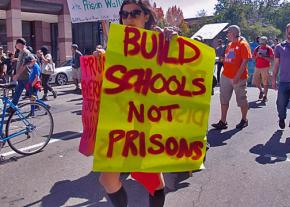Stop the abuse of unfree labor
An Oakland protest in solidarity with the recent prisoners' strike across the U.S. also led to an important debate about property damage, explains .
SOME 250 people gathered in Oakland on September 10 to march in solidarity with the nationwide prison strike begun the day before on the 45th anniversary of the Attica prison uprising. Marchers rallied downtown, then took the streets, chanting "Brick by brick, wall by wall, we will make your prisons fall" and "Prisons are for burning!"
The rally began at Latham Square with a speech by a member of the Industrial Workers of the World's Incarcerated Workers Organizing Committee, which is working with prisoners on the inside to build solidarity and had a strong presence at the Oakland event. Other local organizers then addressed the crowd, and the rally finished with a recording from two incarcerated organizers involved with the Free Alabama Movement.
The crowd then marched out onto Broadway, blocking traffic. Downtown Oakland is sparsely populated on weekends, but participants handed out flyers to passersby, and the protest received supportive honks from a scattering of drivers.
The march stopped at buildings and storefronts belonging to various companies that profit from prison labor, often paying workers mere pennies per hour.

The first stop was an AT&T building, in protest of AT&T's reported use of prison labor in subcontracted call centers. Next was a UPS store, in protest of the company's use of unfree labor as well as its supply contracts with hundreds of prisons. Finally, marchers stopped in front of a Bank of America (BoA) branch.
At each stop, one or two people in masks sprayed slogans like "fuck prison labor" on the wall or window, while most of the crowd watched. At the BoA branch, a few protesters also broke windows and tore down some of the letters of a "Bank of America" sign, leaving it to read "Ban America."
The small number of visible police trailing the march at a distance did not attempt to interfere with the graffiti or defacement. Shortly after the march left BoA, however, cops stormed into the crowd and snatched, beat and arrested a reported total of three people, allegedly for involvement with the earlier property destruction.
After this, the scattered march regrouped and continued on towards Alameda County's Glenn Dyer Jail. A police line blocked access to the jail, so marchers set off fireworks a couple of blocks away, then headed back to the starting point before dispersing.
WHILE THE damage inflicted at BoA, UPS and AT&T by the graffiti may be deserved, the cost of cleanup to these corporations undoubtedly pales in comparison to the profits they derive from prison labor--even without taking into account the extent to which all corporate profits depend on the division and subordination of the working class, for which prisons are an essential ruling-class tool.
The relatively trivial cost to the property owners will not, however, result in a correspondingly trivial potential harm to those arrested at the hands of the vindictive state.
In this context, we should ask how much property damage really contributes to building the far larger movement, based on the organized power of workers inside and outside of prison, that will be necessary to win our demand of prison abolition.
This is not a new debate in Oakland, but it will continue to be a question as long as many Oaklanders suffering from the city's social crisis see protests primarily as places where people go to invite confrontation with the city's brutal and corrupt police.
Meanwhile, the prisoners' strike has set an inspiring example of resistance in the most difficult of conditions--they need all the solidarity we can organize.


